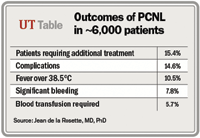Article
PCNL's status as gold-standard procedure affirmed by study
Percutaneous nephrolithotomy is considered the gold standard for the removal of large renal stones. Until recently, however, the procedure's efficacy had not been verified by a clinical study as large as a gold-standard procedure would seem to require.

"In general, urological methods and procedures are not really grounded in evidence-based medicine," said first author Jean de la Rosette, MD, PhD, at the European Association of Urology annual congress. "We often think that clinical studies are not needed, when we, for example, just use a robot. The Endourological Society has therefore embarked on high-quality global clinical studies."
Under the umbrella of the Clinical Research Office of the Endourological Society (CROES), prospective data on the indications for PCNL, its treatment outcomes, and complications were collected from a network of 100 centers worldwide. CROES supplied a simple protocol for the assessment of nearly 6,000 patients.

"Eighty-five percent of the patients did not require additional treatment after PCNL, which must be interpreted as a successful treatment," reported Dr. de la Rosette, who serves as chairman of urology at the Academic Medical Center University Hospital, Amsterdam, the Netherlands. At 30 days follow-up, the stone-free rate was 75.7%.
Low morbidity/complication rate
Dr. de la Rosette and colleagues reported low morbidity and complications rates, with the most common complications being significant bleeding (7.8% of patients), needing blood transfusion (5.7%), and fever over 38.5°C (10.5%). These results, he noted, reflect real-life application of the procedure performed in centers from around the world.
"We are setting up an algorithm in order to identify high-risk patients for complications with the procedure," Dr. de la Rosette pointed out. "This includes older patients with certain age and treatment, obese patients, diabetics, etc."





